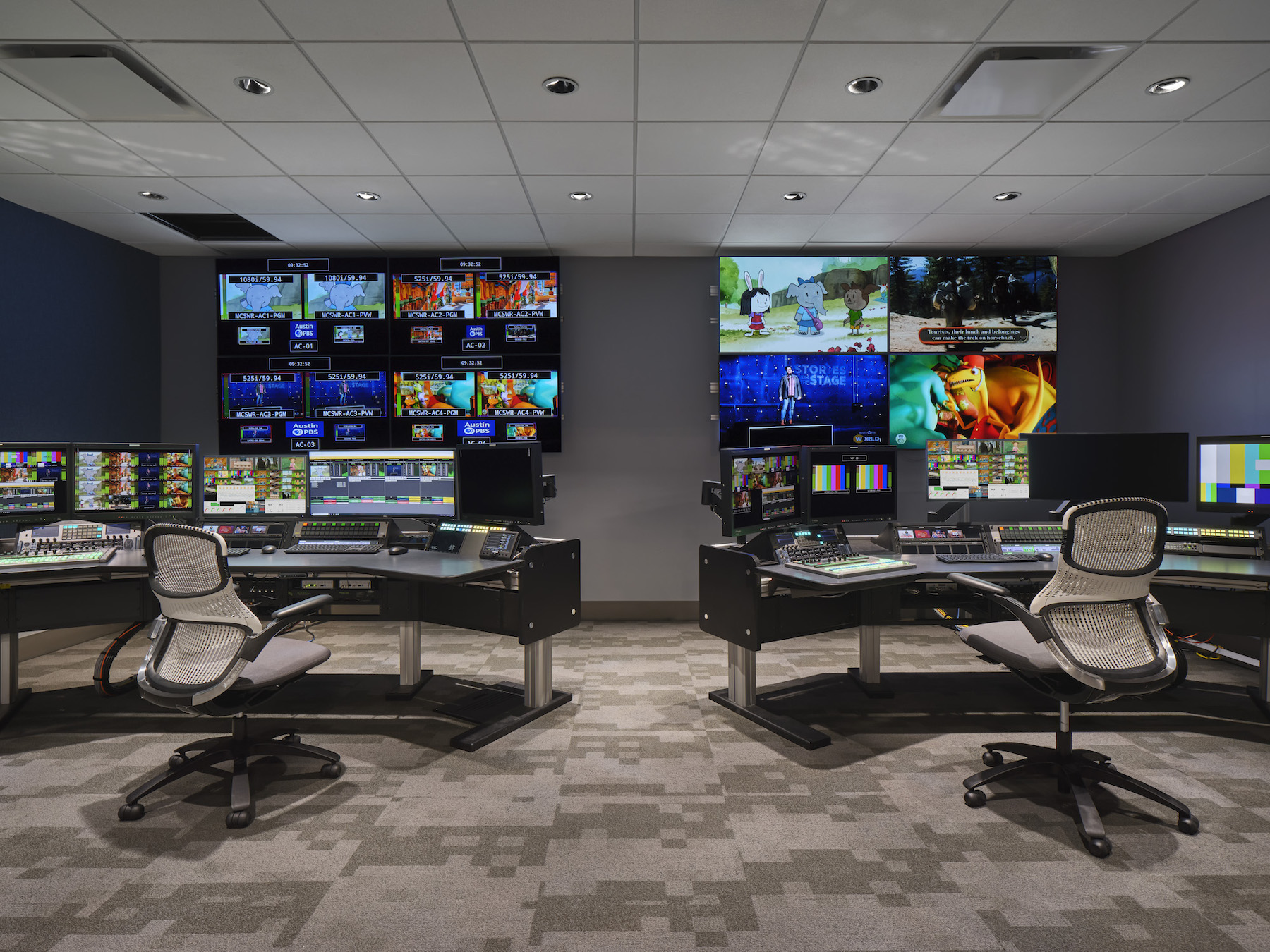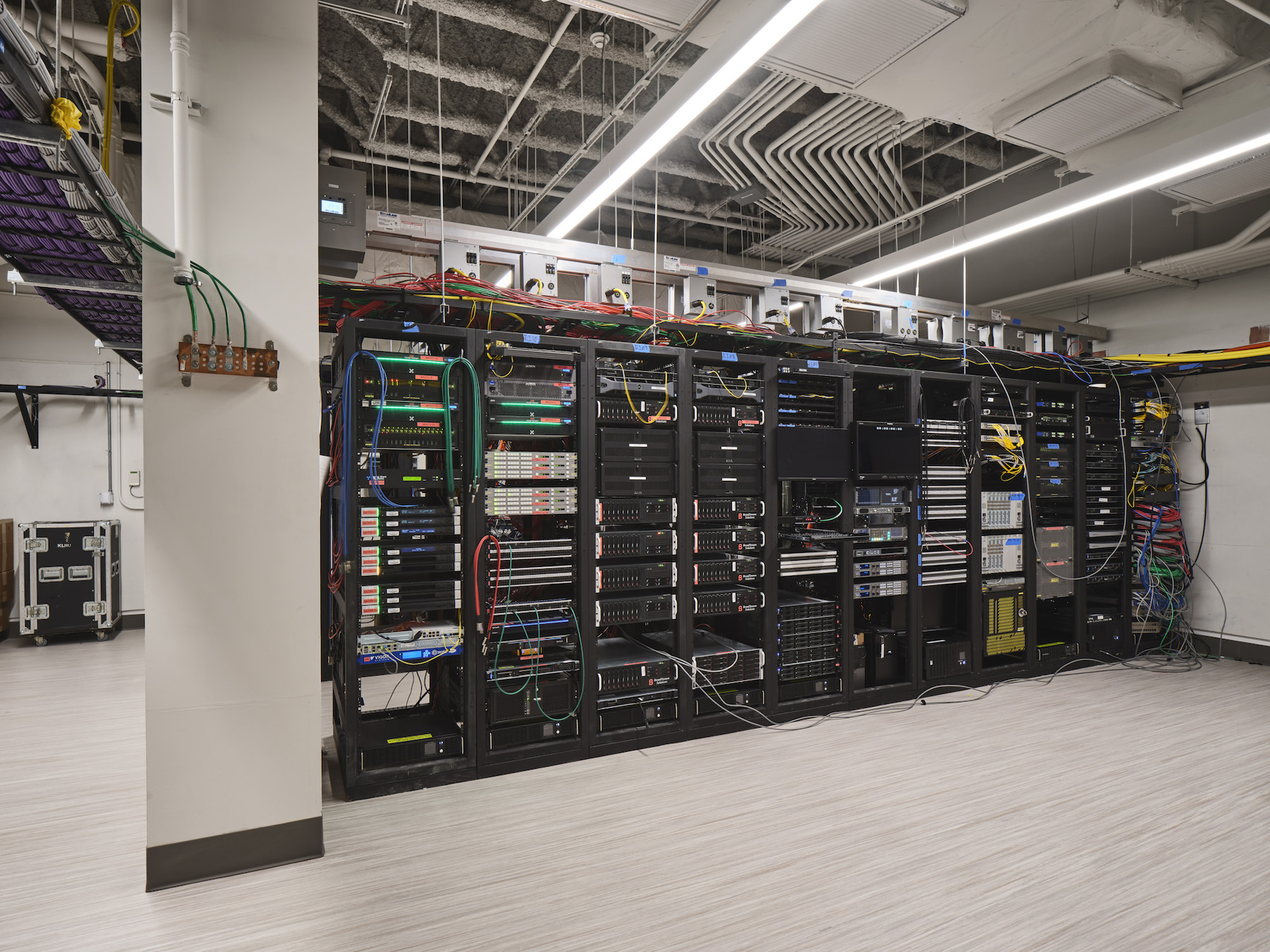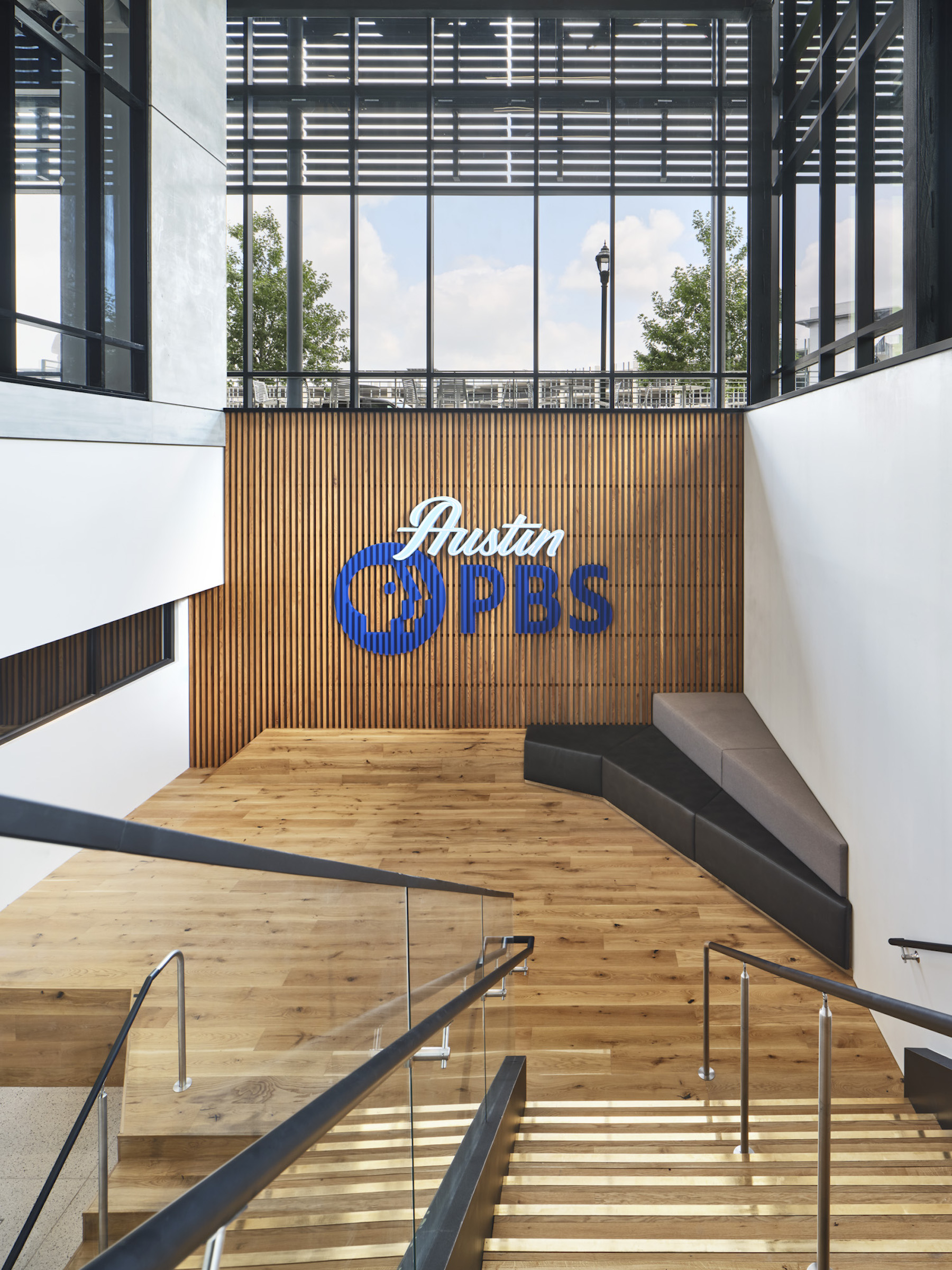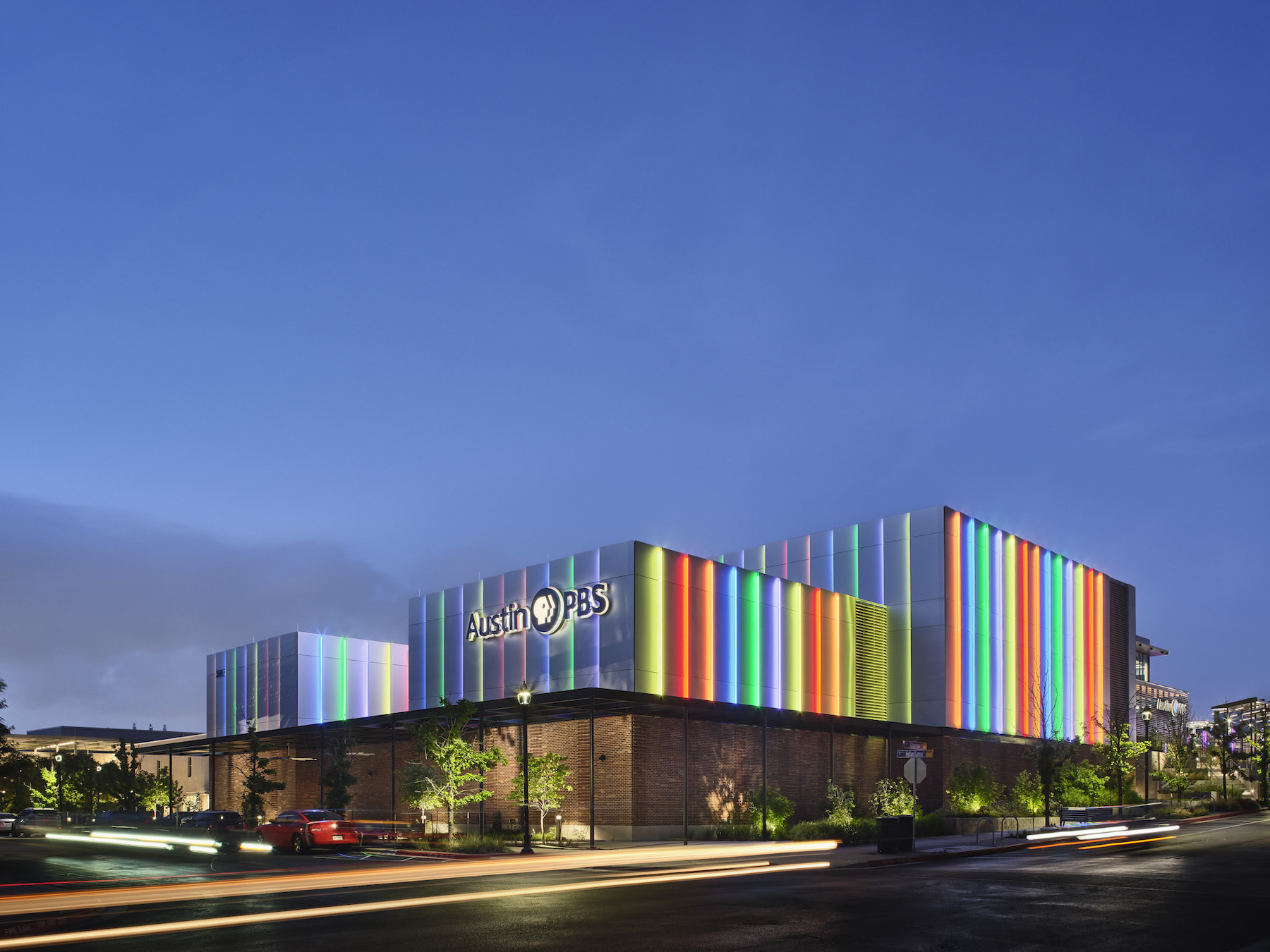Since the 1970s, Austin PBS, birthplace of the Austin City Limits TV series, has been based inside the communications building on the University of Texas campus—a space it has long outgrown. In 2017, the design and planning began for a new state-of-the-art facility located in Austin Community College’s Highland Campus, a former shopping mall.
Designed by Austin architecture firm Studio Steinbomer, the roughly 70,000-square-foot facility, opening this year, has three TV studios. One studio serves as a live audience and community outreach venue. This 6,500-square-foot space has retractable seats and can be reconfigured for live music, town halls, and other productions with live audiences. The other two studios accommodate non-audience programming.
The three studios share walls with workspaces, so the design team placed prime importance on acoustics and sound deadening. The live-audience studio has a floating slab, a silent air conditioner, and highly absorptive materials. So a meeting in the next-door conference room would be undisturbed by a live music performance on the other side of its walls.
Austin PBS’s new home is the first 12-gig digital broadcast network facility for any public television in the US, according to a statement. To highlight the state-of-the art tech, the architects kept much of the 300 miles of cable fully exposed, housing it in custom channels cut out of the ceiling.
A large portion of the building is partially subgrade. So to mitigate the feeling of being underground, the lighting quality mimics skylights and the sun’s movement, creating circadian rhythms that allow people to sense the time by the quality of light. Interior finishes include a mix of bright colors, natural warm wood tones, and nature-simulating colors. And whimsical, industry-specific details include On-Air lights indicating occupied bathrooms.
On the Building Team:
Owner: Austin Community College
Developer: RedLeaf Properties
Design Architect - Exterior: Gensler Austin
Design Architect, Architect of Record - Interiors: Studio Steinbomer (interior remodel level one, and interior of addition)
MEP engineer: Bay & Associates Inc.
Structural engineers: Cardno and Tsen Engineering
General contractor: Rogers-O’Brien Construction
Construction manager: PMA (Project Management Advisors)



Related Stories
| Aug 11, 2010
Florida International University's cantilevered design
Suffolk Construction's Miami-Dade business unit is serving as GC for the $14 million School of International and Public Affairs building at the University Park Campus of Florida International University. Designed by Arquitectonica, Miami, the five-story, 58,408-sf building will have a café and three auditoriums on the ground level; the largest auditorium will have a 40-foot cantilever abov...
| Aug 11, 2010
Restoration gives new life to New Formalism icon
The $30 million upgrade, restoration, and expansion of the Mark Taper Forum in Los Angeles was completed by the team of Rios Clementi Hale Studios (architect), Harley Ellis Devereaux (executive architect/MEP), KPFF (structural engineer), and Taisei Construction (GC). Work on the Welton Becket-designed 1967 complex included an overhaul of the auditorium, lighting, and acoustics.
| Aug 11, 2010
Construction material prices drop slightly in April, extending the decline
The construction materials price index for nonresidential buildings fell 0.3% in April extending the decline since the September index peak to 13.1%. Prices for the mix of materials used in nonresidential construction prices are back to the December 2007 level before the 14% jump in prices from March through September.
| Aug 11, 2010
Research Facility Breaks the Mold
In the market for state-of-the-art biomedical research space in Boston's Longwood Medical Area? Good news: there are still two floors available in the Center for Life Science | Boston, a multi-tenant, speculative high-rise research building designed by Tsoi/Kobus & Associates, Boston, and developed by Lyme Properties, Hanover, N.
| Aug 11, 2010
Piano's 'Flying Carpet'
Italian architect Renzo Piano refers to his $294 million, 264,000-sf Modern Wing of the Art Institute of Chicago as a “temple of light.” That's all well and good, but how did Piano and the engineers from London-based Arup create an almost entirely naturally lit interior while still protecting the priceless works of art in the Institute's third-floor galleries from dangerous ultravio...
| Aug 11, 2010
Precast All the Way
For years, precast concrete has been viewed as a mass-produced product with no personality or visual appeal—the vanilla of building materials. Thanks to recent technological innovations in precast molds and thin veneers, however, that image is changing. As precast—concrete building components that are poured and molded offsite—continues to develop a vibrant personality all it...
| Aug 11, 2010
Bronze Award: John G. Shedd Aquarium, Chicago, Ill.
To complete the $55 million renovation of the historic John G. Shedd Aquarium in the allotted 17-month schedule, the Building Team had to move fast to renovate and update exhibit and back-of-house maintenance spaces, expand the visitor group holding area, upgrade the mechanical systems, and construct a single-story steel structure on top of the existing oceanarium to accommodate staff office sp...
| Aug 11, 2010
AIA Course: Building with concrete – Design and construction techniques
Concrete maintains a special reputation for strength, durability, flexibility, and sustainability. These associations and a host of other factors have made it one of the most widely used building materials globally in just one century. Take this free AIA/CES course from Building Design+Construction and earn 1.0 AIA learning unit.
| Aug 11, 2010
Blue-Light Schoolhouses
Add the explosion in the number of school-aged kids nationally to the glut of huge, vacant stores in many communities and what do you get? Big boxes being turned into schools. For districts facing population pressure, these empty retail buildings can be the key to creating classrooms quickly, and at a significant cost advantage.
| Aug 11, 2010
Great Solutions: Green Building
27. Next-Generation Green Roofs Sprout up in New York New York is not particularly known for its green roofs, but two recent projects may put the Big Apple on the map. In spring 2010, the Lincoln Center for the Performing Arts will debut one of the nation's first fully walkable green roofs. Located across from the Juilliard School in Lincoln Center's North Plaza, Illumination Lawn will consist ...







